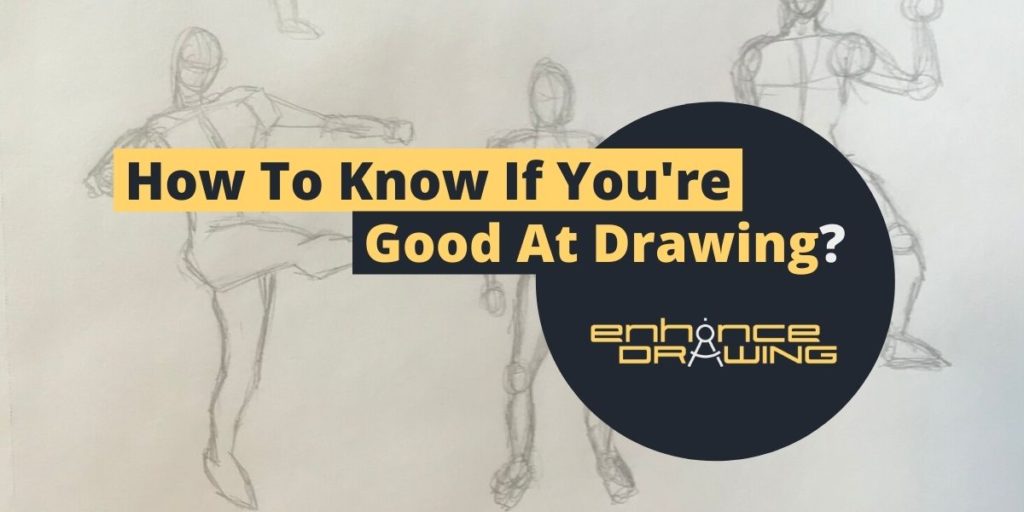
As artists, we are very critical of our work. However, when we want to know if we are good at drawing, we depend on other people’s opinions. However, we need to consider that a regular person’s view vs. the view of a drawing master will be highly different. So you can’t help but wonder, how to know if you’re good at drawing?
To know if you’re good at drawing, you need to read people’s signs and be objective. You will know if you’re good at drawing if you share your drawings with different people and ask for their opinions. If most people like your drawings, chances are you are probably good at drawing.
However, if you don’t have the experience to tell if you’re good at drawing and none of the people around you are expert drawing artists, how can you be sure you are good at drawing on your own? After reading this article, you will have all the tools you need to be an objective artist.
How To Know If You’re Good At Drawing?
Every time we finish a drawing, multiple feelings like admiration, happiness, and doubt arise. It is almost impossible not to question our drawings, especially when learning to draw. However, you must keep into account that no artist is born an expert and that becoming a good, skilled artist takes time. So, since every artist is at a different point in their drawing journey, you need to identify where you are to determine if you are good at drawing. Here are the top 3 things you must consider:
- How long have you actually been learning to draw? The time you have been learning to draw plays a significant role when determining if someone is especially good at drawing. For example, if you have been drawing for a year and can’t draw something people usually learn to draw after three years of practicing, it wouldn’t mean you are bad at drawing. It would mean you just need more time.
- How do your old drawings look like compared to your newest ones? When you draw every day, it is hard to tell how good you get at drawing. A great indicator to know if you’re good at drawing is to take a look at your old art and compare it to your new art. (I’ll explain this more in detail shortly)
- Are there things you’re especially good at drawing and others you can’t yet do? It may sound like a weird question to consider, but usually, if you can draw some things at an above-average level and can’t draw other things, this means you’re good at drawing but don’t have enough experience of the subject you can’t draw. You have probably heard of case studies; here, you would draw the same subject over and over again, from different angles and sizes until you fully understand it.
So, based on the three aspects above, I want you to reach some conclusions.
Right after the conclusions, I’ll share with you a test you can do that once finished, will let you know if you (personally) are good at drawing or not.
1If you haven’t been drawing for a reasonable time, following a proper drawing routine, and practicing daily, you cannot say you aren’t good at drawing. You cannot say it because you haven’t tested your true potential. I have a blog where you can see how long it takes to learn to draw, with images and examples. Use it to find where you are in your drawing journey. (Click on the image below to visit it)
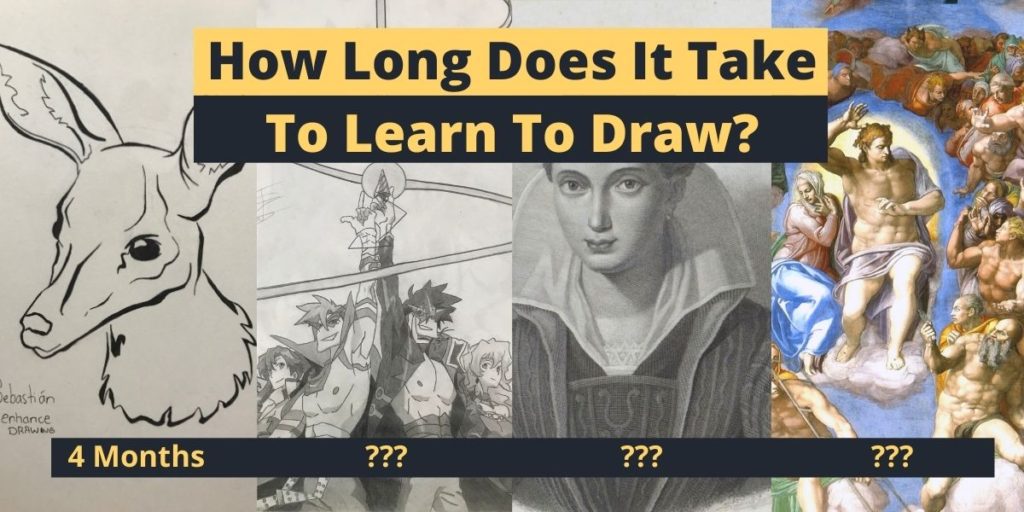
2If you compare your old drawings to your newest ones, and you see they are better now, you’re good at drawing; at this point, it’s a matter of time for you to continue improving your drawing skills. Make sure you compare drawings that have at least a month-time difference. Keep in mind that it wouldn’t be a good example if you didn’t practice drawing daily during that month. For your reference, this is how a regular learning curve looks like for drawing artists.
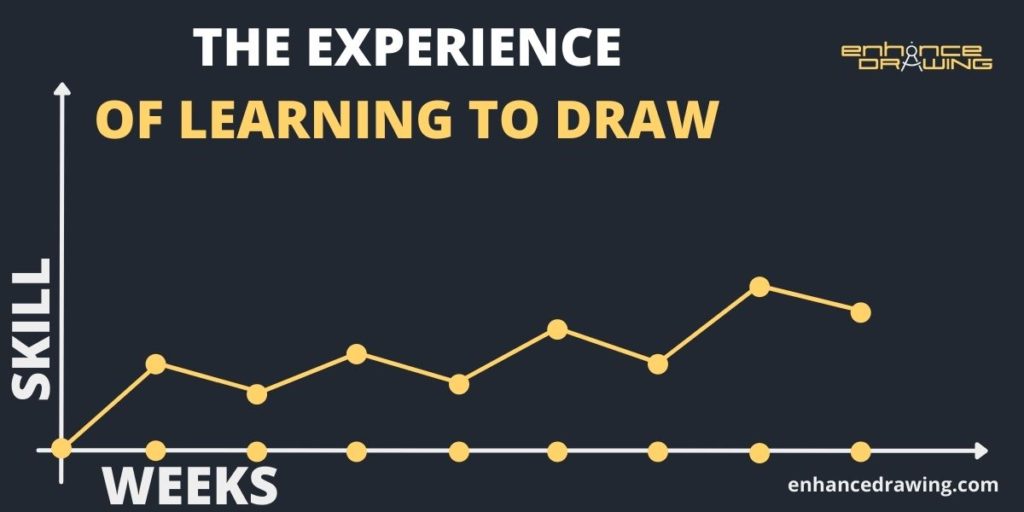
As you can see, you start with a big jump because you go from nothing to something. Then, since the knowledge you’re acquiring is very new and your basis isn’t solid, your skill level goes down, and it looks like you didn’t improve, but note that it didn’t go to zero! So basically, like many things in life, learning to draw has its ups and downs, but if you don’t stop drawing, it will just be a matter of time for you to hit your drawing goals.
3Finally, if there are things you can draw very well, you have the skill. Therefore, what you need at this point is to study the subjects you can’t draw well and understand them. You can do two things to improve at drawing subjects you don’t have much experience with: improve your observational skills or study the subject. To improve your observational skills, you can visit this blog about drawing upside down (click on the image below to visit it), in which I explain this in detail. To find how to study a subject, you can visit this blog about drawing without copying, in which I give you a step-by-step guide on how to study a subject.
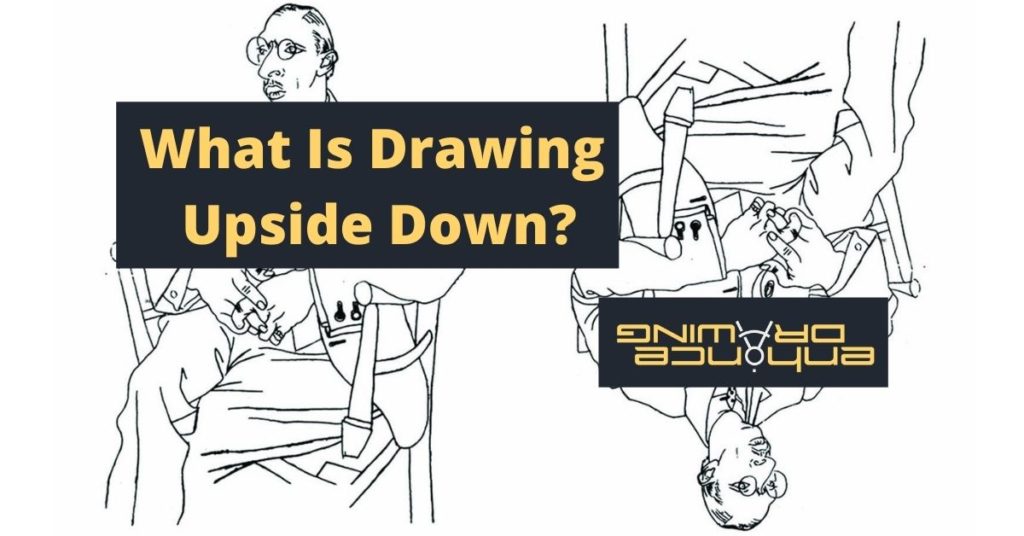
The Promised, Ultimate Test To Know If You Are Good At Drawing
The only way you can tell if you’re good at drawing is by drawing every day for at least a month to evaluate your progress. It must be a month because there isn’t a single artist in the world who took a pencil and knew how to draw without practice or experience. So, with that in mind, these are the steps you need to follow to complete the test.
1- Keep A Record Of Your Drawings
Make sure that every drawing or practice you do is safely stored so you can review it in a month. Having a sketch or drawing book would be helpful.
2- Pick A Subject To Draw
Pick a subject that represents a challenge for you, but remember not to pick something extremely difficult. If you’d like a recommendation, I would pick skulls. They are hard to draw, and understanding their structure is the first step to learning the anatomy of a face, so they will be useful in the long run if you continue drawing.
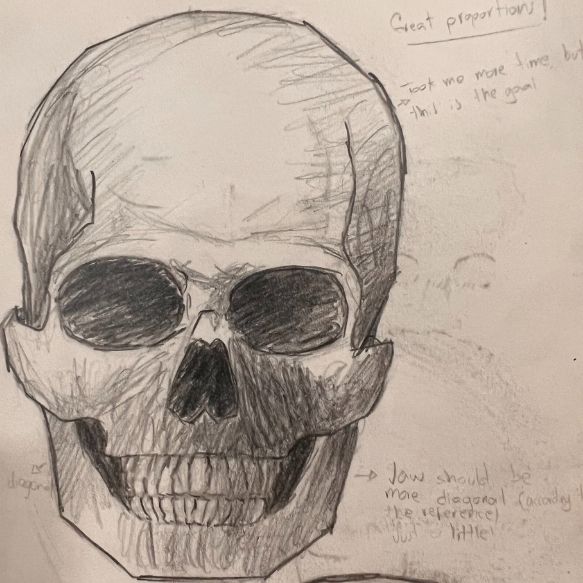
3- Draw The Subject From Different Angles
In the beginning, I couldn’t draw skulls as accurately as I do now. I had to draw hundreds of skulls from different perspectives before making them look like a human skull and not an alien one, haha. Below are some pictures of the skulls I drew when I was practicing; feel free to use them for your reference.
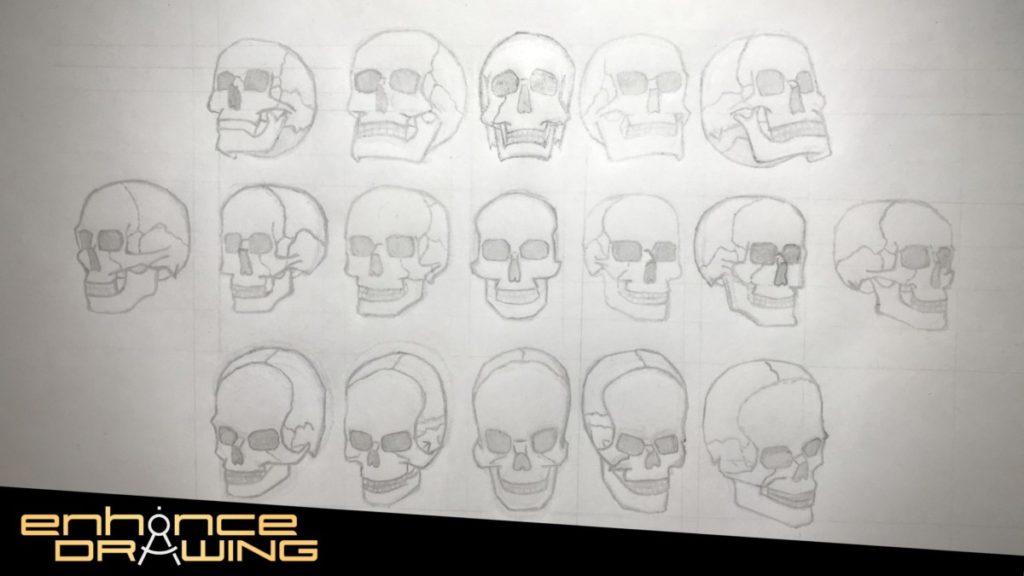
In the end, you would have drawn so many skulls you will be able to draw them without using references. They’ll be stored in your mind as a reward for your hard work.
4- After A Month, Compare Your First Drawing To Your Last One
The more skulls you draw a day, the faster you will see improvements. You can see progress as soon as in a day or two, so imagine the results you’ll see in a month. If you master the skull structure in less than a month, try adding more details. You can also go for another subject study.

If you finish this test and don’t see any positive results (which I doubt), the only thing I would recommend for you before giving up on drawing would be to consult a drawing expert. There may be something essential you’re doing wrong, but that is probably fixable.
On a personal note: I know how it feels to think you can’t draw, and it is something many artists ask ourselves. But I truly believe that anyone can draw; it is just a matter of time. So if you like drawing, do it for all the benefits it may bring to your life, and don’t worry about the results too much; these will naturally show over time. 🙂
If you have done this and still feel like your drawing are getting worse, I recommend you read this blog about why you feel your drawings are getting worse, and all the things you can do to fix it.
Now, let’s say you have already analyzed the three aspects above, and you cannot reach a clear conclusion about your drawing skills. If this is your case, we might have to dig in a little deeper.
What Makes Someone Good At Drawing?
Art is very subjective, and even among the greatest artists of a time, it seems like they cannot meet in a single resolution when it comes to deciding what makes someone a great artist. To give you an example, I will talk about Georges Seurat and Paul Signac, the creators of pointillism. In the beginning, art critics mocked them and ridiculized their art style, and then pointillism became one of the most significant artistic movements of the 19’s century.
Tip: Don’t get discouraged if other people don’t accept or admire your art. It’s impossible to please everyone, and I’m sure some people will appreciate anything you create from your heart. The only person that needs to like your drawings is yourself.
And to make this question even harder to answer, art changes radically over time, so how can we objectively say what makes someone good at drawing?
You can consider someone to be good at drawing if the artist can represent subjects accurately without using aiding tools like grids or such. In addition, a good drawing artist has comprehensive knowledge about theory, drawing principles, and a good dominion of the technique.
But this may confuse you a bit, so let me explain this more in detail: the most important aspect that differentiates a good drawing artist from an average one is their observational skills. Why? Because the human brain prioritizes the overall picture before the details.
For example, have you ever looked at a tree and started counting how many leaves it had? Probably not; you just give it a quick look and immediately identify it as a tree. Further, with human faces, we are even more careless; we are so good at recognizing faces that we see them in piles of clothes, shadows, clouds, etc. So, in the end, if you want to see the details, you’ll have to focus your attention on the subject.
So, how is this connected to drawing anything? Well, when you draw, you must focus on the details. Even minimalist drawings with a few lines include a lot of detail; where the lines start and end, the angle they have, how thick they are, and almost every aspect of them contributes to the drawing. Therefore, the slightest mistake can make a realistic drawing look anything but genuine.
So, if you want to level up your drawing, learning to see is a vital skill you’ll need. You can visit the blog I created about drawing upside down (linked above in the paragraph with the big 3) or read the book Drawing With The Right Side Of The Brain by Betty Edwards, which also explains this in detail.
Apart from this, another big difference between good drawing artists and average ones is how well they know the drawing principles like perspective, value (light and dark), line quality, and more. I’ve seen many cases where there are people that have drawn for years without studying any theory, and although they can draw well, artists who studied theory and have been drawing for less time can draw much better.
Tip #2: I know studying drawing theory isn’t fun for many people, but think about it this way; if you like drawing so much, but you sometimes feel frustrated because you cannot make your hands do what your brain is telling them, wouldn’t it be a more relaxing and rewarding experience if you could draw anything you want at any time? Well, if you study and practice enough, you will reach a drawing level in which you will be able to do that. So try to find ways to make your practices as enjoyable as possible until they become a habit, and then nothing will stop you.
Finally, there is another common question about this exact topic that is very interesting. Apart from knowing if you’re good at drawing, is there any way you could tell if you have an exceptional talent for drawing?
How To Know If You Have Drawing Talent?
First of all, it is essential to note that drawing is more of a skill than a talent, but you can easily tell when someone is really talented at it. However, of all the factors that contribute to someone being good at drawing, how can you know if you have drawing talent?
To know if you have drawing talent, you need to see how quickly you can learn to draw anything compared to other people following a similar drawing routine. When a person has an unusual talent for drawing, you can usually tell because of the speed they learn to draw complex subjects.
I’ve been drawing for years, and I’ve seen a lot of artists improve over time. What’s interesting about this experience is that I’ve seen several artists, all practicing for the same amount of hours a week, with very similar drawing routines. And although most of them improved at a similar pace, some of them learned very quickly; there are a lot of factors contributing to this, but the most obvious one is that the people that improved faster than others have more talent for drawing in general.
However, I’ve also seen how these highly talented people are often bested over more consistent and disciplined people. Talent is rare, and I can 100% confirm that behind the drawing skills most artists you admire have, there are thousands of hours of practice, studying, and drawing. You don’t have to take my word for it; you can go ahead and look for any professional artist telling you that drawing is pure talent and zero practice or skill, and you won’t find anyone saying that. I’ve done it.
So my point is that if you want to become a better artist, you will have to put in the effort to study, practice, and draw a lot. Anyone can learn to draw well at any age, and you’re not the exception. If you learn a little faster than others, that would be amazing! But if you don’t, there’s nothing to worry about; most professional artists were in your exact shoes, and they just continued drawing until they became better.
And to finish this article, I’d like to address why I think many people ask themselves if they are good at drawing or not.
Who Are You Comparing Your Art To?
I think many people wonder if they are good at drawing because they compare themselves with people who have studied and practiced drawing much more than them. And this is even more intense when they see someone younger than them draw a lot better.
I get how you may feel because I was there! But if there’s something I want you to know after reading this article is this: regardless of how well anyone draws, you don’t know for sure how long they have been doing it! Even if they are ten years younger than you, they could’ve been drawing every day since they were five. And does that mean that you can only learn to draw if you start at a young age? No.
In fact, you can learn to draw at any age, and if you have enough time, you can become an extremely skilled artist. Let’s suppose the artist you admire the most has practiced drawing for 20,000 hours; that means that if you want to draw like she (or he), you need to put in the effort to practice, study and draw for the same amount of hours that person has been drawing.
You’re smart, and you can be disciplined, consistent, and anything else you want if you decide it. 🙂
I hope this article helped you in any way! And if you’d like to continue learning about drawing, you’re most welcome to continue reading here at Enhance Drawing.
I hope you the best on your artistic journey. Happy drawing!

